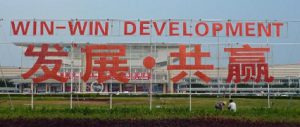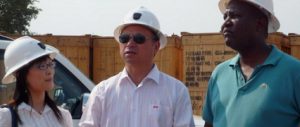As outlined in the previous section of this article, Chinese investments in fields such as energy, mining, dam construction, forestry and agriculture have had complex social and environmental consequences for countries in Africa.
Chinese energy investments in Africa mostly focus on oil. According to the 2009 Analysis of Chinese Oil Imports and Exports by Tian Churong, African oil producers, such as Angola, Sudan and Libya, exported 61.42 million tonnes of crude oil to China that year, accounting for 30.1% of China’s total crude imports.
Chinese investment in mining has also heated up in the last few years – private investment, in particular. Labour disputes in Zambia, mentioned in the previous part of this article, exposed private mining companies as only employing “temporary workers”, not paying welfare – and in the most prominent case, using relationships with the authorities to put down disputes, and firearms to deal with workers’ protests. Since Chinese firms often ignore civil society and requests for dialogue with NGOs, they miss out on opportunities to ease such conflicts and exacerbate the negative impacts of their investments.
Dam projects, another key area of investment, are hugely expensive – and can cause significant social and environmental impacts. NGOs like US-based International Rivers, authors of China’s Environmental Footprint in Africa, have expressed concerns about several dams on the continent either proposed or under construction by Chinese companies, including: the Bui Dam in Ghana, which will flood one quarter of the Bui National Park; Gabon’s Kongou Dam, which will have impacts on forests in the Ivindo National Park; Sudan’s Merowe Dam, where fluctuating water levels and sedimentation could have serious negative effects on aquatic ecosystems, water quality and public health; Ethiopia’s Gibe III Dam and Mozambique’s Mphanda Nkuwa Dam.
The environmental and social impacts of the Mphanda Nkuwa hydropower project in Mozambique are fairly typical. The project was first proposed in April 2006 and China Export-Import Bank pledged to finance it. Energy minister Salvador Namburete approved it in August 2010 and banks will finance 70% of the construction costs.
The proposal was met with concern from local environmental groups; some tried to lobby China Exim Bank to withhold their support for the project. Why? Because the Cahora Bassa dam, built in the 1970s, provides enough electricity for all of Mozambique, but its power is sold off to nearby South Africa – even the capital city, Maputo, has to purchase its electricity back from its neighbour. Mozambique does not lack power, it lacks infrastructure, such as a power grid – over 80% of the country is not yet on the grid and less than 10% of the population use electricity. Most of the power from the US$2.3 billion dam would still be sold to South Africa. Moreover, the Zambezi Delta has for decades suffered erosion due to the Cahora Bassa Dam. An ecological restoration project is planned, but the Mphanda Nkuwa Dam will mean that the environment is doomed.
Many dams in Africa will have similar social and environmental impacts. Local residents often do not benefit from the electricity or economic development, but are displaced and lose their fishing or farming livelihoods. Since these projects often lack transparency and financing comes from overseas, it is hard for local NGOs to help protect the rights of residents.
Investment in dam-building on international rivers should be approached even more cautiously. This year and last, Kenyans took to the streets in protest against Chinese dam investment – opposing the US$500 million loan from the Industrial and Commercial Bank of China (ICBC) for Ethiopia’s Gibe III dam.
The main cause of deforestation in countries like Gabon, Cameroon, Equatorial Guinea, Republic of Congo and Mozambique has been the illegal trade in timber. These countries often have good forest protection policies and laws, but NGOs who monitor forest protection and the timber trade say that these are not enforced, often due to corruption. Timber traders, some of whom are Chinese, often encourage locals to fell trees and the authorities do not have the resources to supervise. For example, it is estimated that in 2005, 94% of all timber produced in Tanzania was logged illegally. Besides the environmental destruction, the rapid reduction in timber resources affects local people who relied on the forests for their livelihood. According to China Safari by Michel Beuret and Serge Michel, Chinese traders have been accused of trapping endangered animals while logging trees.
One problem highlighted by Chinese investment in Africa is that Chinese government policy only provides basic outlines, often without detailed regulations and standards for implementation – or openness and public participation in that process. Therefore, observers are unclear about the extent to which regulations are being carried out.
For example, China’s regulations on the management of overseas aid projects specifically state that there must be both a feasibility study and a technical study, which should have different emphases and be carried out by different parties. But there are no details on what those studies should contain; how important evaluation of social and environmental effects should be; or the standards for evaluation.
China itself was once a major recipient of aid and the country’s experiences are an important part of its overseas aid policy, especially when tackling difficult questions. How can international aid help with education, infrastructure, poverty alleviation and water safety? How to protect local economies as they open up? How to protect the interests of farmers? How can the environment be protected as the economy develops? Understanding China’s experience and discussing these questions can help to offset the negative impacts of investment.
It is only the on the basis of this open discussion that China can improve its policies on aid and investment in Africa.
Yi Yimin is project officer at Moving Mountains, where she researches the social and environmental impact of economic development in China and overseas. Yi is a member of Friends of Nature.
Image by David Haberlah shows the Merowe Dam construction site.
Part one: Parallels at home




![India, Uttarakhand, Haridwar, dam on the Ganga [image: Alamy]](https://dialogue.earth/content/uploads/2020/03/P1YATT-300x200.jpg)

